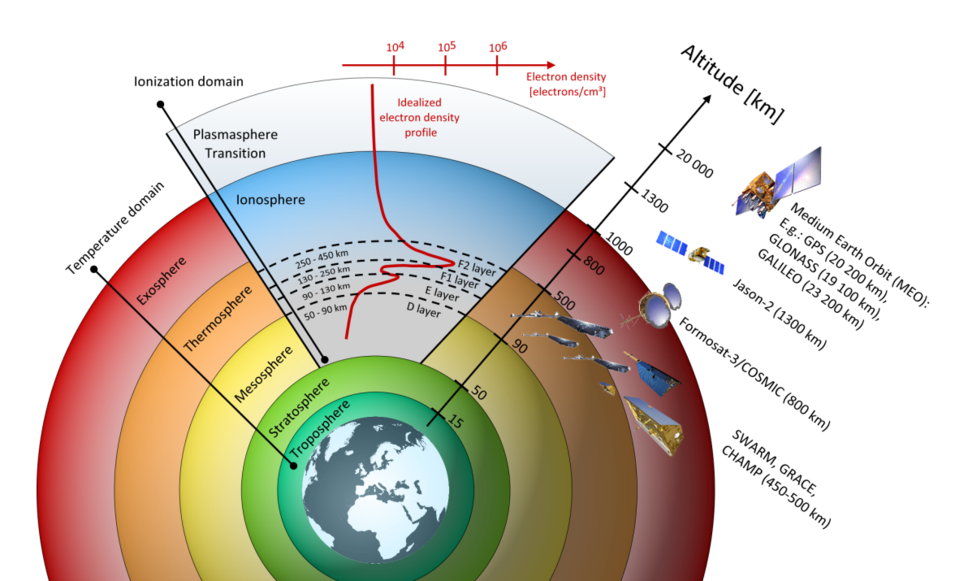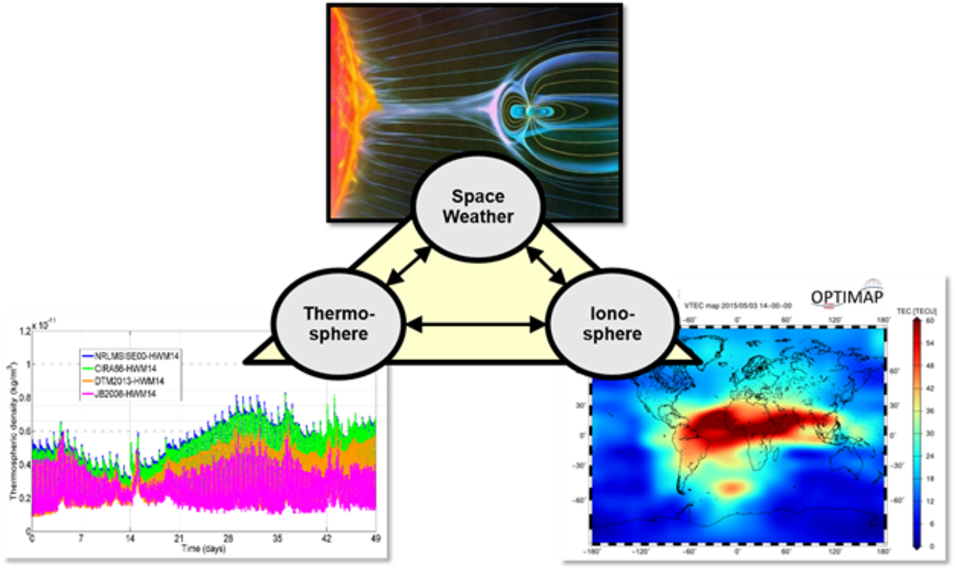Atmosphere
Driven by the activity of the Sun as well as the Earth's gravity and magnetic field, the Earth’s atmosphere can be decomposed into different layers defined, for instance, by chemical composition, temperature and degree of ionization. Following the temperature profile, the atmosphere can be split into the troposphere, stratosphere, mesosphere, thermosphere and exosphere (left part of Fig. 1). Following the degree of ionization, the atmosphere can be composed into the neutral atmosphere up to around 50 km altitude, the ionosphere from 50 km up to around 1000 km and the plasmasphere above. Furthermore, Fig. 1 illustrates that the thermosphere coincides with the region of highest ionization, i.e. with the so-called F2 layer of the ionosphere. Consequently, strong physical interactions exist between the neutral density as the key quantity of the thermosphere and the electron density as the corresponding key quantity of the ionosphere. Ionosphere is also seen as a manifestation of space weather, i.e. it reflects the response of the Earth to solar phenomena such as solar wind and coronal mass ejections.

From the historical perspective the geodetic community considered the atmosphere as a disturbing quantity which has to be corrected. In modern geodesy, however, it is also seen as a target quantity since almost all geodetic measurement techniques provide valuable information about the state of the atmosphere during the measurement process. Consequently, the joint evaluation of measurements from heterogeneous space-geodetic observation techniques such as terrestrial GNSS, satellite altimetry, DORIS and radio occultations from Low-Earth-Orbiting (LEO) satellites meets the GGOS goal of providing high precision and consistent atmosphere products. GGOS also addresses societal issues such as global change and space weather. Since our modern society is highly depending on space-borne systems, e.g., for communication and navigation, space weather and its risks are gaining more and more importance in politics and sciences.
Figure 1 shows on the right side the orbit heights of satellites from various recent space-geodetic missions such as GRACE, Swarm and Jason-3. One principle problem of these missions, which are studied at DGFI-TUM within the topic `atmosphere, can be formulated as follows: whereas the trajectories of LEO satellites with orbit heights less than 800 km are significantly influenced by the thermosphere, the observations of their measurement systems are distorted by the ionosphere. Since thermosphere and ionosphere are physically coupled, a joint evaluation must be the final goal of thermosphere-ionosphere studies and projects.

Figure 2 shows the key parameter for the ionosphere, the integrated electron density in form of a VTEC map (bottom right panel), and the key variable of the thermosphere, i.e. the neutral density computed from several empirical thermosphere models (bottom left panel). Since the neutral density is related to the electron density, both are influenced by space weather activities. The interrelations of space weather with the ionosphere and the thermosphere can be visualized by a triangle. Following the above mentioned interrelations we currently concentrate our research on the following Tasks.
Tasks
Arcisstraße 21
80333 München